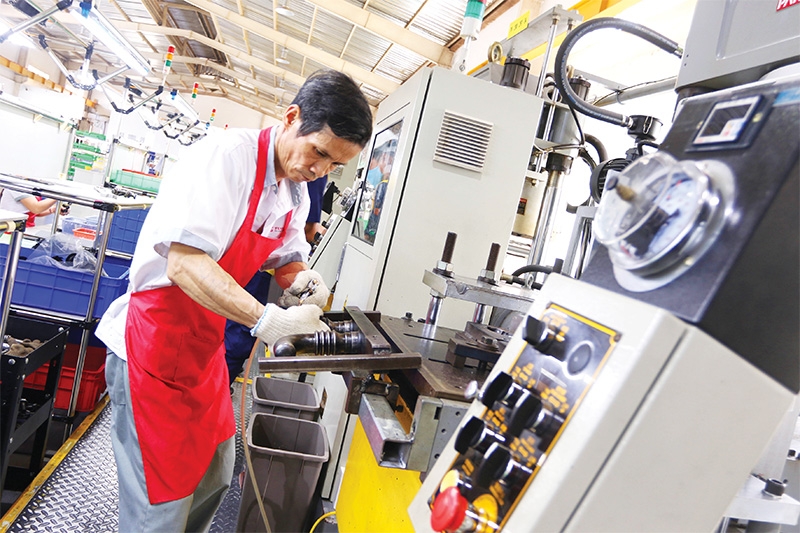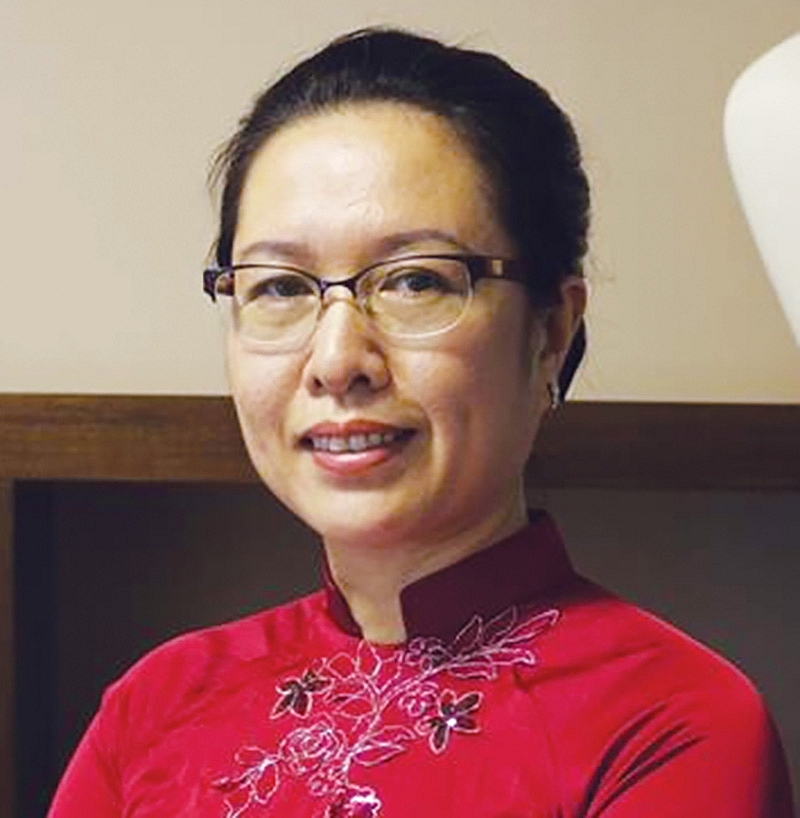Building on economic resilience for the future
 |
| In the next five years, Vietnam aims to restructure its economy towards more resilience and sustainability, photo Le Toan |
Throughout the last few decades, Vietnam has been constantly searching for new drivers for economic growth, and the economic consequences of the COVID-19 pandemic have even further encouraged the government and businesses to look for new ways of economic restructuring.
Following the guidance of the Ministry of Planning and Investment, the Central Institute for Economic Management (CIEM) is the focal point for drafting, evaluating, and monitoring economic restructuring and innovative growth models. The research results will contribute directly to the plan on economic restructuring for the 2021-2025 period which is to be submitted to the government, the central agencies, and the National Assembly in 2021.
In this draft project, the CIEM focuses on analysing several restructuring areas including state-owned enterprises (SOEs), public investment, credit institutions, state budget, public services, eight market production factors, industry restructuring, and private sector development to serve as a basis for proposing solutions for the 2021-2025 period, with a vision to 2030.
Key focal points
The global health crisis has been impacting many countries around the world, also leaving serious implications for Vietnam’s economic development and social stability. The most direct consequence has been the slowdown in economic growth, noticeable particularly with the widespread recession.
Dr. Dang Thi Thu Hoai, head of the CIEM’s Department for Sectoral and Economic Studies, said that the restructuring process of the economy between 2016 and 2020 has achieved many positive results. By the end of the year, 16 of the 23 major targets assigned in the government’s Resolution No.27/NQ-CP/2017 are expected to be completed. Of these, five important goals have achieved results far beyond the set plan, contributing to creating substantial progress in economic restructuring.
While Vietnam has reached these successes, Hoai said that there are still limitations. Public investment remains spread out, and its disbursement is slow and ineffective, with the quality of public institutions being low. Moreover, the budget collection system is not sustainable, especially in the context of the pandemic.
Furthermore, the objectives of improving the efficiency and competitiveness of SOEs have not been completed. The autonomous processes of public non-business units are slow, especially in finance, while the scale and financial capacity of credit institutions are still limited, rendering the restructuring of weak credit institutions incomplete and leaving bad debts potentially risky.
According to the CIEM, Vietnam has not yet achieved its previous goals for 2011-2020, especially the ones that determine the ability to overcome the middle-income trap on the country’s development path. Growth has improved but basically remains broad, with resources used with poor efficiency.
Thus, the restructuring of the economy, as well as the reforming of the growth model, continues to be an issue for the next five years. It is necessary to focus on improving the efficiency of resource allocation through synchronous development of all types of markets combined with taking advantage of the opportunities of digital technology and innovation, according to the CIEM.
The results of restructuring the three focus areas – public investment, SOEs, and credit institutions – are an important premise for the next five years to focus on development and a more synchronous system of market types, thereby building a healthy, fair, and favourable business environment that promotes innovation and the development of the private sector.
As the Vietnamese economy has been suffering from the negative impacts of the pandemic, huge changes appeared, especially in terms of economic structure, governance, and economic activities, including daily ones of each individual.
Dr. Cao Viet Sinh, former Deputy Minister of Planning and Investment, said that the CIEM’s new draft project should focus on the three vital elements comprising labour productivity, competitiveness, and economic resilience, as he deems these factors crucial in determining the health of Vietnam’s economy.
Building a restructuring scheme for 2021-2025 requires in-depth research and analysis, including the possible impact of economic restructuring. However, as the plan naturally has a wide scope, efforts to restructure the economy in the past, “have been mainly focused on cleaning up the consequences of previous development stages,” Sinh argued.
Marketisation of land
In the next five years, effective decisions to allocate resources in the economy according to the market mechanism will affect the formation of a healthy and competitive environment – a prerequisite for promoting technology application and innovation. According to the CIEM, crucial parts of this endeavour include market-oriented amendments to the Land Law, agricultural land use management, and supporting land use rights on the market.
Hoai agreed that early amendments to the Land Law towards more market-oriented agricultural restructuring will improve the efficiency of the resource allocation system. According to the CIEM’s proposal, the law should be amended in the direction of removing limits on who can receive transferred agricultural land use rights, the extension of land allocation terms, and the removal or increase of fill limits, among others.
Furthermore, the CIEM also aims for the abolishment of land allocation mechanisms and instead lease land under administrative procedures. This means rather than the current way of allocating land use rights following someone’s request, the primary market of land use rights should be handled by state auctions and the bidding of land use rights to find suitable investors. Similarly, land that has been recovered by the state for the implementation of socioeconomic development projects should not directly be allocated under the current administrative measures but must be auctioned to find the most appropriate investor.
According to a study published in 2013 by the CIEM, the industries that contribute the most to GDP are not the most invested in. The allocation of investment resources into sectors and localities is currently almost not based on the level of development or efficiency but mainly on administrative factors.
“Resource allocation should be the core focus of economic restructuring in the coming time,” Dr. Nguyen Dinh Cung, member of the Prime Minister’s Economic Advisory Group, commented.
“A non-market resource allocation system that is not based on efficiency is the main reason for economic ineffectiveness,” Dr. Cung emphasised, adding it is not necessary to divide the restructuring scenario by industry or field but rather build an effective allocation mechanism that paves the way to the market.
In the context of a post-pandemic economy, the ways of production and consumption may see significant changes, which will require more appropriate and effective resource allocation principles.
Nguyen Tu Anh, director of the General Economics Department of the Party Central Committee’s Economic Commission, said that along with the principle of reallocating resources, restructuring also includes the selection of priority areas for investment and arrange appropriate rankings. “The allocation of investment has long been ineffective,” said Anh, when referring to the situation that each province gets an increasing rate of investment yearly, while he said focus should lie on large enough investment projects to boost the area or region.
| Dr. Tran Thi Hong Minh - Director, Central Institute for Economic Management
Vietnam has been one of the few relatively successful countries in controlling the pandemic and reducing the consequences for its economy. In addition to timely directions from the government, this result is an important part of the strong and continuous reforms in previous years, which contributes to the improvement of the macroeconomic foundation and resilience. However, many key economic sectors are still severely affected, such as tourism. According to the Central Institute for Economic Management’s studies, global GDP growth may decrease by 1 per cent this year, thus Vietnam’s export growth may also reduce by 4 per cent. Our nation’s economy has achieved encouraging results, but we cannot rest and need to continue to pay attention to strong economic reforms in the coming time, which must also adapt to the new context. The basic requirement is to continue to improve the productivity and competitiveness of the economy and the business community. It is necessary to promote reforms, digital transformation, and sustainable development to create impetuses for the economic development of the next years. |
What the stars mean:
★ Poor ★ ★ Promising ★★★ Good ★★★★ Very good ★★★★★ Exceptional
Related Contents
Latest News
More News
- Forum honours outstanding M&A deals, strategies, and advisory firms (December 09, 2025 | 18:22)
- Vietnam enters defining phase of M&A growth (December 09, 2025 | 17:00)
- Vietnam’s M&A market opens new opportunities amid strong economic momentum (December 09, 2025 | 15:00)
- Vietnam M&A Forum 2025: new position, new momentum (December 09, 2025 | 14:30)
- FDI in Vietnam jumps on additional capital and share purchases (December 09, 2025 | 13:56)
- VIR gathers dealmakers for M&A forum (December 08, 2025 | 17:17)
- Vietnam steps up green transformation with strong policies and rising investment demand (December 06, 2025 | 12:07)
- Listed companies honoured for information transparency (December 06, 2025 | 11:59)
- CSI 2025 highlights rise of Vietnam’s green champions (December 06, 2025 | 09:00)
- Vietnam strengthens energy storage pathway (December 04, 2025 | 15:05)


 Tag:
Tag:




















 Mobile Version
Mobile Version